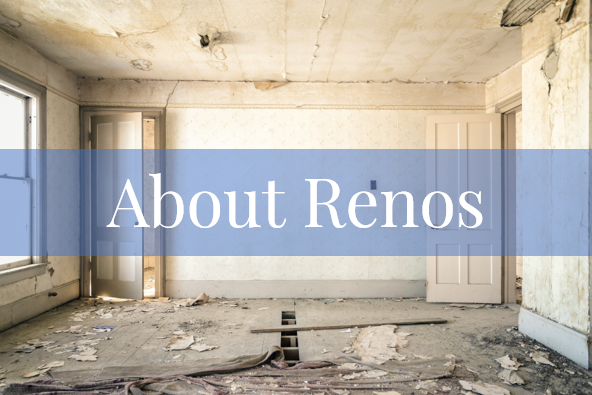Is It Time to Renovate Your Laundry Room?
/One of the benefits of 2nd floor laundry is that you can take care of the laundry while multitasking and getting ready in the morning.
Our laundry rooms are one of the most neglected rooms in our homes when it comes to renovations. It’s not a place where we entertain or even show off to guests. It’s not even a place where we spend much time, or do we?
Prefer to listen?
Why should you renovate your laundry room?
The average family spends about 260 minutes, or just over 4 hours per week, doing laundry. That equates to over 200 hours per year! This is based on two loads of laundry per week. However, many of us do more than two loads per week on average. That’s a lot of time spent doing laundry! If we’re going to spend that much time doing laundry, why do we neglect the laundry room the most?
For most of us, we think of it as a work space that no one sees but us. It’s often dark, not painted or even decorated nicely, and just a place we slip in and out of when we have to. None of us like doing laundry. It’s a chore we have to do. By renovating this space and making it a pleasant area to work in, it makes the task more pleasant as well. Who wouldn’t love to do laundry in a gorgeous laundry room like the one below?
Beautiful laundry room with tiled floor, wood cabinets with lots of storage, and front-loading machines
By renovating your laundry room, you also increase the resale value of your home. Not only does the value of your home increase, but the appeal to potential home buyers increases as well. Who wouldn’t love to see a beautiful laundry room, a space that typically lacks lustre at best?
One of the things we always ensure when we renovate a laundry room for our clients is that we make it more functional for them. For example, we ensure the washer and dryer are next to each other in the right way so clothes can easily go into the dryer from the washing machine without manoeuvring around the appliance doors opening the wrong way.
We also ensure the laundry tub is positioned in a functional location for use. Sometimes our clients never use the laundry tub for anything more than rinsing out paint trays. If you never use your laundry tub to soak clothing, towels, etc., then why have it near your washer and dryer?
Do you iron clothes or prefer to fold them in the laundry area? Then you need base cabinets and a countertop in your laundry room. Making the laundry room more functional is always our number one priority when we renovate for our clients.
Also, consider what the rest of your home looks like. If you’ve renovated much of your home and it looks great, your laundry room will look that much worse if it’s not equally stylish. You don’t need to make it a high-end laundry room, but it should at least be renovated similarly to the rest of your home.
Pros and Cons of Having Your Laundry Room on the Main Floor, 2nd Floor, or Basement
A very functional laundry room was renovated from top to bottom for our clients in Ashburn. This laundry room is in a converted small room just off the kitchen on the main floor.
If you’re planning to renovate your laundry room, one of the things you should consider is where it might be best located. Traditionally, it was almost unheard of to have it anywhere other than the basement. Then builders started to move it to the main floor. For a few years, builders started putting laundry rooms on the second floor. Which is best? A lot depends on your personal needs and what you truly find convenient. We explore all the pros and cons of each option to help you decide what is best for you.
Main Floor—Pros
The main floor is where you typically spend most of your time, so this puts the laundry room close by.
The main floor is a good compromise, as it’s closer than dragging your laundry all the way down to the basement (assuming you have a two-storey home).
If you have a bungalow, this puts it at the heart of all of the activity in your home.
Many of our clients who have a laundry room on their main floor will do their cleaning or cooking while running the washer and dryer. If it’s on the main floor, this makes all of these chores very efficient.
Main Floor—Cons
You still have to bring the laundry down from the second floor (if you have a two-storey home).
Main floor laundry rooms can take space away from something you might otherwise use the space for. For example, that space could be used for a mud room or storage closet.
Washing machines in particular can be noisy, and that may disrupt you on the main floor.
2nd Floor—Pros
The biggest pro for this location is how close the laundry facility is to where the dirty laundry is generated. No more carrying the laundry in baskets down to the laundry room. Convenience is the biggest advantage of this option.
This eliminates the need for hampers. Instead of storing the dirty laundry in a hamper, you can just take it right to the laundry room and leave it there, or even place it directly into the washing machine.
2nd Floor—Cons
Just like the main floor laundry, a second-floor laundry can take up valuable space that might be better suited for something else. For example, a 2nd-floor laundry might have to go into a clothes closet, a linen closet, or take space from a bedroom, making that area smaller.
The noise that comes from the washer and dryer can be an issue if you’re doing your laundry at night while you’re trying to relax or sleep.
If your washing machine floods, this can cause a lot of damage to your flooring, walls, and ceiling below. There are ways to prevent and deal with this. Keep reading for our tips below on preventing flooding.
You will need to put vibration pads on the washing machine to ensure it doesn’t vibrate and "walk".
Stacking your washer and dryer maximizes your space and allows a laundry facility to be positioned just about anywhere.
Basement Laundry—Pros
There’s usually lots of room in your basement, so it won’t take up valuable space in your main living areas. You can even put your laundry room in an unfinished portion of the basement to ensure you don’t take up space you need to save for entertaining.
If your washing machine does flood, there (usually) won’t be damage to the ceiling or walls.
The noise the machines make is not usually a problem since it’s in your basement, away from where you spend most of your time.
Basement Laundry—Cons
If you have a two-storey home, this is a long way to have to carry the laundry back and forth.
If your laundry room is in the basement, it’s not usually visually pleasing, as it’s normally in an unfinished area.
There’s usually limited natural light as basement windows are usually small. This just makes the area darker and less pleasant to complete an otherwise unpleasant task.
Because the laundry is in the basement, making it farther to carry a laundry basket, laundry will sometimes pile up because it’s not convenient to do it.
Preventing flooding if you plan to have your laundry facilities on the 2nd floor
I find our clients either love or hate the idea of the laundry room on the 2nd floor. There is no in-between. If you’re thinking about having the laundry room on the second floor, there are some things you really need to be prepared for.
You need to plan for the unexpected, and that means the potential of a washing machine flood. Here are some things you should do to prepare.
Position your washing machine on a drain pan. This is an easy, inexpensive way to prevent water damage from a leaking washing machine. A drain pan slides under your washing machine and provides the first line of defence against leaks, accidental spillage, or anything else that might drip from it.
Install a leak detector. This will sound an alarm if it detects water letting you know of a problem right away. There are washing machine leak detectors that will not only sound an alarm but will also automatically turn off the water supply to the washing machine to prevent further damage.
Make sure your shut-off valves are accessible so you can turn the water off to the machine quickly. Try turning them on and off again once per month to ensure they haven’t seized. We recommend installing quarter-turn shut-off valves as the most reliable valves. We also recommend turning the water supply to the washing machine off when it’s not in use. I know this can be inconvenient, but it really is the best way to prevent problems.
Ensure your washing machine hoses are the metal-braided flex type and not just the plastic type.
Electrical Requirements for Laundry Rooms
Having your laundry facilities combined with a mud room allows for a multifunctional space on the main floor.
If you’re renovating your laundry room, there are a few things you need to comply with to ensure electrical safety and meet Ontario Electrical Code and Ontario Building Code requirements.
If you have base cabinets and a countertop in your laundry room, you will need to install a dedicated receptacle for ironing. Even if you do not plan on ever doing any ironing, it is an Electrical Safety Code requirement to have this dedicated receptacle in place.
You will also need to install an exhaust fan vented to the exterior if one currently doesn’t exist. As your washing machine and dryer create a lot of heat, humidity, and moisture, the exhaust fan will collect and remove that moisture rather than spreading it throughout your home.
Lastly, if your washing machine receptacle or any other receptacle is within 1 meter of a water source, it should be GFCI protected. We recommend any receptacles in bathrooms or laundry rooms be GFCI protected for your safety, no matter how close they are to a water source.
One room that's often not considered for improvement is the laundry room. But you spend a lot of time in your laundry room, and it definitely gets a workout. It should be updated like any other room. The best renovations are those that make laundry rooms more convenient and functional. Take a look at your laundry room the next time you’re doing laundry. Is there something you can do to renovate it to make it brighter, more welcoming, and more efficient? If you need some advice on your potential renovation, please connect with us, and we’d be happy to help. Click here to send us a message.




























